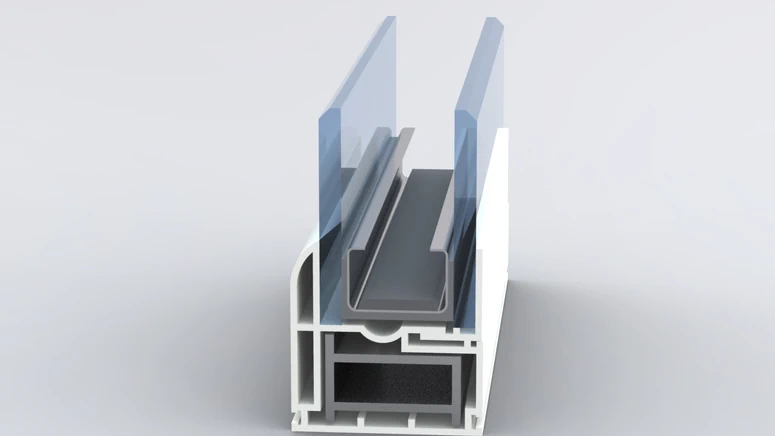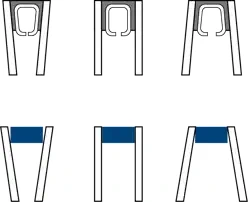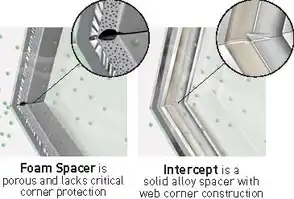
When it comes to windows, homeowners are familiar with the parts of windows they can see, like the glass, the frame, and the hardware. But what about what’s inside the window?
Components of a Window
Every window unit is comprised of two (or sometimes three) panes of glass separated by a spacer that holds the panes together, creating an insulating air space where a safe gas, such as argon or krypton, can be added to protect the home from heat loss and the outside elements.
The spacers are a critical part of every window unit. They separate the panes of glass, providing the insulating glass unit within the window with structural integrity along with a thermal and moisture seal that enhances the window’s thermal performance. Without an effective spacer, the window’s performance will be diminished and may ultimately fail.
The majority of spacers are made of either metal or foam. The Intercept® Spacer System uses either tin-plated steel or stainless steel because they are stronger and more durable than foam and provide excellent thermal performance. The Intercept Ultra Spacer System uses a proprietary, formulated stainless steel which when compared to foam or composite-based space, is stronger, more durable, and completely leak-proof. Making it the industry-leading thermal performing “warm edge” spacer system.
When evaluating spacer performance and reliability, consider these important features that spacers must possess in order to be effective. They include:
Strength
- Durability
- Thermal performance
- Strength

Metal spacers, especially those made of stainless steel, are by far the strongest spacers available. The Intercept Spacer, a naturally energy efficient design, supports seal longevity and gas retention by allowing the glass and sealant to move with the normal expansion and contraction of insulating glass throughout the day due to temperature changes. This flexibility eliminates the stress on both the sealant and the spacer, allowing all the components to work together seamlessly, making it a stronger solution. In fact, each window manufactured with The Intercept Spacer System is made using highly automated precision equipment to ensure a tight and secure seal that enables the window to retain the insulating gas.
Another benefit of the Intercept Spacer System is how it looks inside the window. With its rigidity and strong seal, it sits tight between the two panes of glass and gives the window a crisp, clean look with uninterrupted sight lines. Foam spacers are often placed by hand inside the insulating glass unit within a window. Because foam is a very pliable, porous, spongy material, it can be difficult to apply between the two panes of glass resulting in non-straight lines which can intrude into the window’s sight lines.
Glenn the Glass Guy tested the strength of the Intercept Stainless Steel Spacer versus a typical foam spacer. Watch the “Strength and Aesthetics” video to see how Intercept held up against the competition.
Durability

The reason why spacer material must be durable can be summed up in two words: Gas Retention. In between those panes of glass is an invisible gas, such as argon or krypton. The spacers separate the panes of glass, creating the space where the insulating gas is inserted. However, the gas molecules will look for any place to escape. That is why a special sealant is used in every window unit to bond the spacer at the edges and corners to provide a moisture vapor barrier and ensure that the gas cannot escape. This sealant, combined with metal’s impervious characteristics, improves gas retention and maximizes the insulation value of the window over the long run.
Therefore, a durable stainless steel window spacer not only ensures that the window will maintain its structural integrity, but also that it will retain its insulating value over time.
Thermal Performance
Intercept Stainless Steel Spacer’s durability helps it to retain a window’s insulating gas. In the “Durability and Gas Retention” video, Glenn the Glass Guy illustrates this using a foam football.
One of the main reasons homeowners purchase new windows is for improved energy efficiency in their homes. While it’s a hidden component of the overall window, the spacer is an extremely critical component in ensuring the window’s thermal performance.
When it comes to thermal performance, the Intercept spacer and foam spacers are equal. However, a myth being propagated by foam spacer manufacturers is that metal spacers lead to poor thermal performance in a window. Using scientific evidence and thermal imaging technology, it has been proven that Intercept stainless steel spacers are just as effective as foam when it comes to thermal performance.

Compare the two images. The first is a thermograph or “heat picture” of a window manufactured with the Intercept Spacer System. The second is a thermograph of a window manufactured with a foam spacer. There is very little difference in these images. Why?
When measuring the U-value of each window–a measure of the insulating characteristics of the total window unit–both values are equal. In fact, you must go three places beyond the decimal point to spot any difference at all.
What good is a window if it doesn’t keep the elements out? In the “Thermal Performance” video, Glenn the Glass Guy uses a thermal imaging camera to compare the insulating value of a window with the Intercept Stainless Steel Spacer to a window with a foam spacer.
As a homeowner you are going to make a significant investment in your home by purchasing new windows. Style, color and cost are all very important factors to consider. It is equally important to understand and consider the components of a window that you don’t usually see, such as the spacer.
Before you decide on new windows, ask your window sales representative what spacer system they use. For the strongest, most durable and energy-efficient window, ask them for windows with the Intercept Spacer System.
Learn More About Spacers
GED is a partner in this technology with Vitro Architectural Glass (formerly PPG glass). Glenn the Glass Guy is the biggest glass and window enthusiast! He knows that every component that goes into making a window is important. This includes what type of window spacer is used to separate the panes of glass. Join Glenn in his lab as he puts the Intercept Stainless Steel Spacers to the test against foam spacers.
For more information please visit Glenn the Glass Guy on the GED YouTube channel.
Learn more about Intercept spacer fabrication systems and spacer material types on our website.

Written By: John Moore
With 30+ years of industrial marketing experience, John C. Moore joined GED in 2017 as V.P. of Marketing and works closely with Sales to seek out and evaluate market opportunities, launch new products, and oversee marketing communication efforts. John has his M.B.A. from John Carroll University and B.S. from Miami University.


